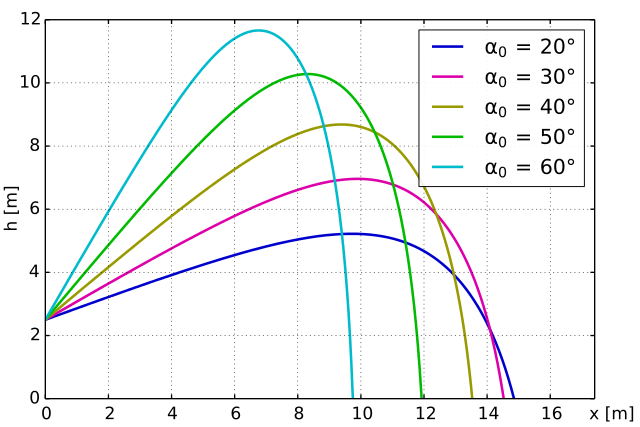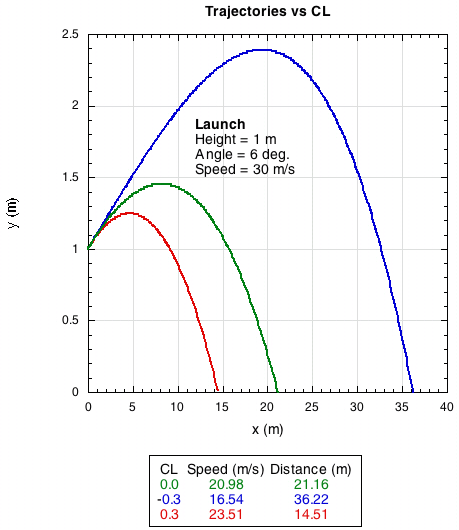You are using an out of date browser. It may not display this or other websites correctly.
You should upgrade or use an alternative browser.
You should upgrade or use an alternative browser.
Forehand MPH Question. Physics Experts Only!
- Thread starter Raul_SJ
- Start date
ForehandCross
G.O.A.T.
I know basic physics only, but without any idea of the resistive force applied by the fence, the rotational energy present in the ball initially, the coefficient of elasticity of the surface(the energy lost to ground) we can never guess the speed of the ball when it left the racquet
Raul_SJ
G.O.A.T.
I know basic physics only, but without any idea of the resistive force applied by the fence, the rotational energy present in the ball initially, the coefficient of elasticity of the surface(the energy lost to ground) we can never guess the speed of the ball when it left the racquet
More info for you: It was a cement hard court. Hand feed, so assume close to zero initial rotation and incoming velocity. You have the net clearance of three feet over the center of the net and bounce location at center of opposite baseline. So only a certain mph plus/minus 5 mph should produce that type of trajectory path.
Last edited:
You really need some kind of time vs distance measurement.
In videos some people use frames per second of the video to calculate time and we know the size of the court to calculate how far the ball has moved at certain points. (click your keyboard arrow buttons to move 1 frame in youtube)
So number of frames moved / frames per second speed of the video will give you time.
e.g 20 frames/ 30fps = 0.666 seconds
tennis court is 78 feet = 0.01477 miles
0.666 seconds / 60 / 60 = 0.000185 hours
0.01477 miles / 0.000185 hours = 79.83 mph
So a ball that takes 20 frames to travel from one side of the court to the other on a 30fps video moved at 79.83 mph.
In videos some people use frames per second of the video to calculate time and we know the size of the court to calculate how far the ball has moved at certain points. (click your keyboard arrow buttons to move 1 frame in youtube)
So number of frames moved / frames per second speed of the video will give you time.
e.g 20 frames/ 30fps = 0.666 seconds
tennis court is 78 feet = 0.01477 miles
0.666 seconds / 60 / 60 = 0.000185 hours
0.01477 miles / 0.000185 hours = 79.83 mph
So a ball that takes 20 frames to travel from one side of the court to the other on a 30fps video moved at 79.83 mph.
Raul_SJ
G.O.A.T.
Use the equations of parabolic motion of a projectile
What value for the launch angle?
Harry_Wild
G.O.A.T.
Just get to a tennis academy that has a speed gun built in to the court! Get a person in the academy to set it up so it registers your groundstrokes. Look at the display after hitting it or get an accumulation of each of your groundstrokes for you to view a minute or two later on.
Chas Tennis
G.O.A.T.
Repeat this shot with a video camera square on to the side of the trajectory.
D = t x v
D - distance travelled in one frame time.
t = frame time of the camera.
v = forehand speed.
100 MPH = 1760"/sec
at 100 MPH a ball travels 58.7" in a frame time of 1/30 second.
D = t x v
D - distance travelled in one frame time.
t = frame time of the camera.
v = forehand speed.
100 MPH = 1760"/sec
at 100 MPH a ball travels 58.7" in a frame time of 1/30 second.
Last edited:
zill
Legend
Forehand hit from the baseline cleared the net by three feet and bounced on the opposite baseline and was then buried into the back fence 5.0 feet high. Had to yank it out of the fence. About a quarter of the ball was in the fence.
Any way to estimate the forehand mph?

Can you do it again? That is the question.
SystemicAnomaly
Bionic Poster
@Raul_SJ @Chas Tennis
With badminton shuttles there is very little or no Magnus effect present. However shuttles experience a considerable amount of air drag. High deep serves and clears will deviate from a parabolic path considerably. Badminton shuttles represent a rather extreme air drag case. But it does illustrate that even without Magnus forces present, air drag can have an appreciable effect on projectile trajectory.
 www.zigya.com
www.zigya.com

 www.semanticscholar.org
www.semanticscholar.org
Might work for those who played tennis in a vacuum (in a fairly uniform gravitational field). Most of us do not. Both air drag and Magnus forces will affect the trajectory of the ball. Ball trajectories will deviate from a parabolic path a fair amount. This will happen in the tennis, cricket, baseball and other sports, especially with fast spinning balls.Use the equations of parabolic motion of a projectile
With badminton shuttles there is very little or no Magnus effect present. However shuttles experience a considerable amount of air drag. High deep serves and clears will deviate from a parabolic path considerably. Badminton shuttles represent a rather extreme air drag case. But it does illustrate that even without Magnus forces present, air drag can have an appreciable effect on projectile trajectory.
Tennis Ball Trajectories — The Role of Aerodynamic Drag and Lift in Tennis Shots"
Study to determine how aerodynamic drag and lift forces influence the flight of a tennis ball and to determine the drag and lift coefficients that define these forces.
twu.tennis-warehouse.com
Explain why: (e) A spinning cricket ball in air does not follow
A spinning cricket ball has two simultaneous motions types of motion- rotatory and linear. These two types of motion oppose the effect of each other. This decr

[PDF] A Study of Shuttlecock's Trajectory in Badminton. | Semantic Scholar
The result showed that the motion equation of a shuttlecock's flight trajectory could be constructed by determining the terminal velocity, which could be used to replace the traditional subjective method of the Badminton World Federation based on players' striking shuttlecocks. The main purpose...
SystemicAnomaly
Bionic Poster
Trajectories -- high air drag:


SystemicAnomaly
Bionic Poster
Tennis Ball Trajectories — The Role of Aerodynamic Drag and Lift in Tennis Shots"
Study to determine how aerodynamic drag and lift forces influence the flight of a tennis ball and to determine the drag and lift coefficients that define these forces.
twu.tennis-warehouse.com

SystemicAnomaly
Bionic Poster
Too many unknowns. Launch angle and initial ball velocity. Spin type & magnitude. Humidity, elevation (altitude) / air pressure, wind direction & magnitude. Coefficient of restitution of the court surface. Ambient temperature. Ball temperature and other characteristics (rubber stiffness, internal air pressure, etc)
Amount & fluffiness of the ball felt will affect amount of air drag. Spin will affect pre-bounce trajectory as well as the height, angle -- nature of the bounce -- as well as the post bounce trajectory
How much the ball is embedded into the fence will also be affected by exactly how (where) the fence is contacted. If the ball impacts the fence squarely at an opening, it will inbed deeper than other impacts. The same ball might not inbed in the fence at all if it hits a metal intersection directly or sufficiently close to directly.

 link.springer.com
link.springer.com
Amount & fluffiness of the ball felt will affect amount of air drag. Spin will affect pre-bounce trajectory as well as the height, angle -- nature of the bounce -- as well as the post bounce trajectory
How much the ball is embedded into the fence will also be affected by exactly how (where) the fence is contacted. If the ball impacts the fence squarely at an opening, it will inbed deeper than other impacts. The same ball might not inbed in the fence at all if it hits a metal intersection directly or sufficiently close to directly.

Measurements of the horizontal and vertical speeds of tennis courts - Sports Engineering
Tennis courts are normally classified as fast or slow depending on whether the coefficient of sliding friction (COF) between the ball and the surface is respectively small or large. This classification is based on the fact that the change in horizontal ball speed is directly proportional to the...
onehandbh
G.O.A.T.
Impossible to even make an estimate without more information, especialy on the amount of time it took to reach the fence. Speed is distance / time. With the information on the amount of time it took for this event, we can sort of work backwards and estimate the horizontal speed vector and loss of speed after the bounce, etc.Forehand hit from the baseline cleared the net by three feet and bounced on the opposite baseline and was then buried into the back fence 5.0 feet high. Had to yank it out of the fence. About a quarter of the ball was in the fence.
Any way to estimate the forehand mph?

It's like asking someone how much force was applied to a punch and only giving the following information:
the guy took a big swing and it hit me in the stomach and it really hurt.
SystemicAnomaly
Bionic Poster
Perhaps if you give us the size of the bruise left by the punch and how long it took for the bruise to disappear, then we could provide you with an educated guess.Impossible to even make an estimate without more information, especialy on the amount of time it took to reach the fence. Speed is distance / time. With the information on the amount of time it took for this event, we can sort of work backwards and estimate the horizontal speed vector and loss of speed after the bounce, etc.
It's like asking someone how much force was applied to a punch and only giving the following information:
the guy took a big swing and it hit me in the stomach and it really hurt.
SystemicAnomaly
Bionic Poster
More details please. One-inch punch? Popeye windup punch?Impossible to even make an estimate without more information, especialy on the amount of time it took to reach the fence. Speed is distance / time. With the information on the amount of time it took for this event, we can sort of work backwards and estimate the horizontal speed vector and loss of speed after the bounce, etc.
It's like asking someone how much force was applied to a punch and only giving the following information:
the guy took a big swing and it hit me in the stomach and it really hurt.

SystemicAnomaly
Bionic Poster
Almost there. This is a good first-order (ballpark) estimation. Need to dig deeper, more sophisticated math models, for any real semblance of precision.Precise calculation here:

To simplify, it is..

(please excuse my using of scrap paper. I did it in my spare time while solving a quantum mechanic equation for time travel in hypothetical 4th dimension with consideration for Dark Matters)
You missed a minus sign in front of one of the variables. Im not gonna tell you which one. But just know that without it your equation falls apart so youre gonna have to trial and error it one by one.Precise calculation here:

To simplify, it is..

(please excuse my using of scrap paper. I did it in my spare time while solving a quantum mechanic equation for time travel in hypothetical 4th dimension with consideration for Dark Matters)
JackSockIsTheBest
Professional
I'm lostPrecise calculation here:

To simplify, it is..

(please excuse my using of scrap paper. I did it in my spare time while solving a quantum mechanic equation for time travel in hypothetical 4th dimension with consideration for Dark Matters)
SystemicAnomaly
Bionic Poster
Is it the trig functions or the calculus that is losing you? Or perhaps everything after the first = sign?I'm lost
5263
G.O.A.T.
Imo, your best tool is to recreate the shot on the TW university program that would allow you to input speeds and spin to show several parameters for a shot hit at 3' over the net.Forehand hit from the baseline cleared the net by three feet and bounced on the opposite baseline and was then buried into the back fence 5.0 feet high. Had to yank it out of the fence. About a quarter of the ball was in the fence.
Any way to estimate the forehand mph?

JackSockIsTheBest
Professional
Everything, i'm currently learning algebra so maybe that'll explain my confusionIs it the trig functions or the calculus that is losing you? Or perhaps everything after the first = sign?
user92626
G.O.A.T.
I'm lost
It is sooo easy, bruh.Everything, i'm currently learning algebra so maybe that'll explain my confusion
I already denoted the formula clearly with P being Power; F being Fence, whichever way you want to calculate.
It's clear as daylight.
SystemicAnomaly
Bionic Poster
Precise calculation here:

To simplify, it is..

(please excuse my using of scrap paper. I did it in my spare time while solving a quantum mechanic equation for time travel in hypothetical 4th dimension with consideration for Dark Matters)
Make sure you have a good handle on that algebra. And trigonometry too. You will need them later if you ever survive and make it to calculus. In fact, they are often the most difficult part of calculus / differential equationsEverything, i'm currently learning algebra so maybe that'll explain my confusion
No idea what these equations really are. The dot over the p and the other variables (and constants) denotes that they are derivatives (calculus). Capital T usually indicates temperature. So p might be pressure in the first equation. However, p is often also commonly used for momentum. That might make sense since m is mass. L is commonly used for angular momentum.
I did a search on that first set of 6 equations. It did not match up with anything I found except for some joke memes:
Last edited:
JackSockIsTheBest
Professional
Bro, chill. Just saying i'm not there yetIt is sooo easy, bruh.
I already denoted the formula clearly with P being Power; F being Fence, whichever way you want to calculate.
It's clear as daylight.
SystemicAnomaly
Bionic Poster
Pretty sure that post was meant as a joke. As was his posting of the complex mystery equationsBro, chill. Just saying i'm not there yet
JackSockIsTheBest
Professional
Oh, I always take everything so seriously...Pretty sure that post was meant as a joke. As was his posting of the complex mystery equations
user92626
G.O.A.T.
Me too, ever since the 12th ball hit my head the other day.Oh, I always take everything so seriously...
Life is short. You gotta take everything with utmost seriousness.
bitcoinoperated
Professional
No, there are far too many unknowns to even get a rough estimate with what you posted. Spin, roughness of the court, coefficient of restitution of the ball with the court, ball drag co-efficient etc.
Similar threads
- Replies
- 807
- Views
- 79K
- Replies
- 11
- Views
- 3K
- Replies
- 11
- Views
- 364

